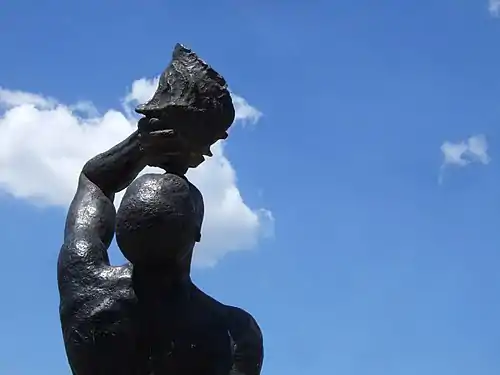Le Marron Inconnu
Le Marron Inconnu de Port au prince,[4] shortened as Le Marron Inconnu (French pronunciation: [lə ma.ʁɔ̃ ɛ̃.kɔ.ny], "The Unknown Maroon"), also called Neg Marron or Nèg Mawon (Haitian Creole pronunciation: [nɛɡ ma.ʁɔ̃], "Maroon Man"),[5][6] is a bronze statue of a runaway slave, better known as a maroon, standing in the center of Port-au-Prince, Haiti. Completed on September 22 1967 by Haitian architect Albert Mangonès, the statue is regarded as a symbol of black liberation;[7] commemorating in particular, the rallying cry that sparked the Haitian Revolution and the abolishment of slavery. Situated across from the National Palace,[8] it is the nation's most iconic representation of the struggle for freedom.[1][9]
 | |
| 18.5446°N 72.3377°W | |
| Location | Place du Marron Inconnu, Champ de Mars, HT6110 Port-au-Prince, Haiti[1] |
|---|---|
| Designer | Created by Haitian sculptor Albert Mangonès |
| Height | 3.60 metres (11.8 ft) and 2.40 metres (7.9 ft) tall |
| Completion date | 22 September 1967[2][3] |
| Dedicated to | Abolishment of slavery and freedom of all black people |
Description
Mangonès completed the statue on 22 September 1967.[2] It measures 3.60 metres long by 2.40 metres high.[10] It depicts in bronze a near-naked fugitive black man, kneeling on one knee, his torso arched, his opposite leg stretched back, and a broken chain on his left ankle. He holds a conch shell at his lips with his left hand, his head tilted upward to blow it, while the other hand holds a machete on the ground by his right ankle.[5][6][10]
Mangonès chose a passage from 1 Maccabees 14:3-9 of the Jerusalem Bible to be set in copper letters on one of the two concrete panels that protect the "eternal flame" of freedom in the square surrounding the statue.[10]
Recognized usage
In 1989, the United Nations adopted the statue as a central icon on postage stamps commemorating Article 4 of the Universal Declaration of Human Rights that states, "No one shall be held in slavery or servitude; slavery and the slave trade shall be prohibited in all their forms."[1][9][11][12]
Gallery
References
- Comité National Pour La Mémoire et l'Histoire de l'Esclavage - Statue du Marron Inconnu (in French)
- Alphonse, Roberson, ed. (15 May 2012). "Le Marron inconnu vandalisé et la flamme éternelle éteinte". Le Nouvelliste. Retrieved 9 March 2016. (in French)
- Press, ed. (1 January 2010). "1979-2009 - Les 30 années de l'ISPAN" (PDF). Bulletin de l’Ispan (UNESCO). p. 6. Retrieved 9 March 2016. (in French)
- Roberts, Neil (2015). Freedom as Marronage. University of Chicago. p. 12. ISBN 9780226201047. Retrieved 9 March 2016.
- Bell, Beverly, ed. (2013). Fault Lines: Views across Haiti's Divide. p. 32. ISBN 9780801452123. Retrieved 6 April 2016.
- Mukherjee, Jola Dr, ed. (20 March 2010). "History May Be Haiti's Greatest Resource". Huffington Post. Retrieved 7 April 2016.
- "Embassy of the Republic of Haiti - Haiti's Landmarks". Archived from the original on 2016-03-10. Retrieved 2016-03-09.
- Philippe R. Girard (2 November 2011). The Slaves Who Defeated Napoleon: Toussaint Louverture and the Haitian War of Independence, 1801-1804. University of Alabama Press. p. 191. ISBN 978-0-8173-1732-4.
- Press (Obituaries, PASSINGS), ed. (27 April 2002). "Albert Mangones, 85; His Bronze Sculpture Became Haitian Symbol". LA Times. Retrieved 9 March 2016.
- Lorraine, Mangones (ed.). "Le Marron Inconnu (The Unknown Runaway Slave)". Directions. 4 (1): 62. Retrieved 9 March 2016.
- United Nations - The Universal Declaration of Human Rights
- Mangonès, Fréderick, ed. (8 July 2014). "Le Marron Inconnu d'Albert Mangonès". Le Nouvelliste. Retrieved 9 March 2016. (in French)



